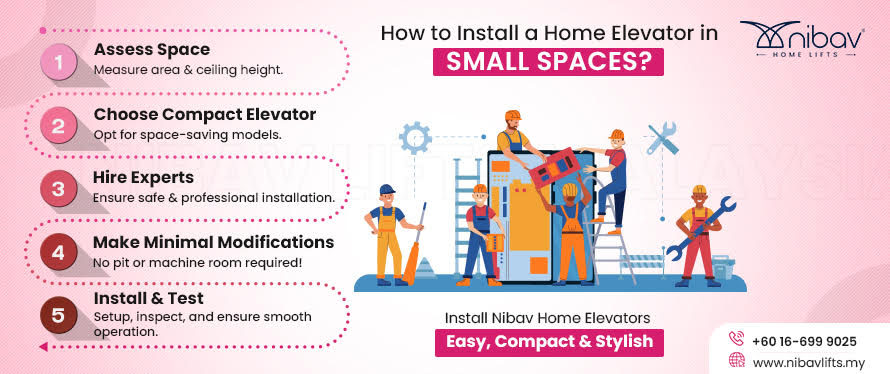A home elevator installation in a small space necessitates careful planning and research. Home elevators for tiny places: the following stages will assist you in navigating the procedure:
- Assess the space: Assess the available space in your home to see if a home lift can be fitted. Consider the elevator shaft’s dimensions, taking into account the clearances, floor space, and required ceiling height. Measure the space to ensure it meets the minimal standards for the elevator model of choice.
- Home elevators for small spaces: Choose a type of home elevator that is specifically designed for small places. Compact elevators, such as pneumatic vacuum elevators, are often suitable for installations with little space. These elevators are designed to fit into small places and have a smaller diameter shaft.
- Hire professional installers: It is critical to use trained elevator installers or specialist elevator installation organizations who have experience working in restricted spaces. They will be armed with the information required to evaluate the location, give recommendations, and ensure proper installation within the available space.
- Obtain permits and approvals: whether you want to install a house elevator in an inconsequential area, check with your local building authorities to see whether any licenses or approvals are required. Throughout the installation procedure, ensure that local building requirements and laws are observed.
- Structural modifications: Depending on how your property was designed and built, you may need to make structural changes to accommodate the elevator shaft. To ensure the building’s structural stability, walls may need to be strengthened.
- Customize your elevator: Working with the elevator manufacturer or installation company, you can customize the elevator to fit the space you have available and your design preferences. Consider choices such as smaller cabin sizes and effective control systems.
- Install elevator components: The installation crew will safely install the elevator’s components, which include the guide rails, traction system, and control panel.
- Test and Certification: Following installation, the elevator will undergo comprehensive testing to ensure optimal performance and compliance with safety rules. This comprises inspecting the safety system, performing load testing, and functional tests.
- Ongoing maintenance: Set up a maintenance plan with the elevator manufacturer or installation company to guarantee that it stays in good operating order. Ongoing upkeep and inspections are essential to guarantee that the home’s elevator runs safely and efficiently.
Keep in mind that the installation procedure for home elevators for small spaces varies based on the manufacturer, kind of elevator, and unique features of your property. To ensure a seamless and secure installation, consult with experts in house elevator installations for small spaces.
Install the Nibav home elevator:
Installing Nibav Vacuum Elevators is not difficult. It is so important that, under the right conditions, it may be refurbished and relocated to another location of comparable size. These pneumatic elevators require no machine room or pit and thus require minimal civil construction. As long as the vacuum elevator meets these basic specifications and has a cylindrical and panoramic glass construction with several access points, it can be installed in any type of home, regardless of flooring type or elevation structure.
FAQ’s
1. How can you install a home elevator in small spaces?
Installing a home elevator in compact areas is easy with Nibav Home Lifts Malaysia. Our space-saving, self-supporting design requires no pit or machine room, making it perfect for small homes. It fits seamlessly while adding value and convenience.

2. Are home elevators safe for seniors and children?
Yes, Nibav Home Lifts Malaysia ensures top-tier safety with advanced features like automatic door locking, battery backup, and smooth operation. Designed for all ages, it provides a secure and comfortable ride, enhancing mobility for seniors and children.
3. What Are the Energy Costs of Using a Home Elevator?
Nibav Home Lifts Malaysia uses minimal power and less energy than a standard washing machine. With air-driven technology, it uses power only during ascent, making it an eco-friendly and cost-effective solution for modern homes.
4. Can a Home Elevator Blend with My Interior Design?
Absolutely! Nibav Home Lifts Malaysia offers customizable colors and sleek aesthetics to match your home’s decor. Its transparent and stylish design enhances modern and traditional interiors, providing a luxurious yet practical mobility solution.
5. How Long Does It Take to Install a Home Elevator?
Installation is quick and hassle-free! Nibav Home Lifts Malaysia can be installed within 24–48 hours without major structural modifications. Its plug-and-play system ensures minimal disruption, giving you instant access to a comfortable home elevator.




